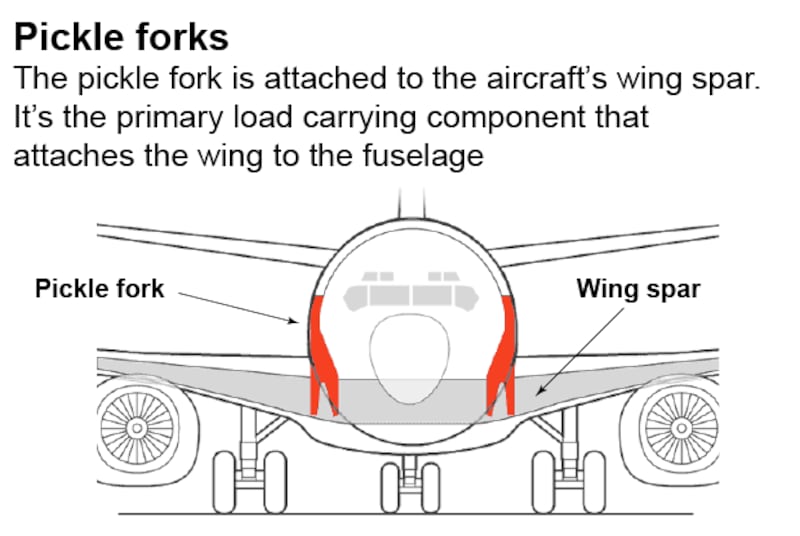At least three Ryanair Boeing 737s have been grounded due to cracks between the wing and fuselage but this was not disclosed to the public.
The airline is the latest to be affected by faults in the “pickle fork” structure, which has sparked an urgent grounding of 50 planes globally since October 3rd.
While other airlines, such as Australia’s Qantas and America’s Southwest, have disclosed the number of their planes affected by the cracks, Ryanair – which operates the largest fleet of 737s in Europe – has previously refused to confirm how many of its planes have been affected.
Last Thursday, the airline told The Irish Times it “does not expect” the global pickle fork issue would “have any impact upon our operations or fleet availability”. The Guardian reported on Wednesday that three of its planes have been affected by the issue.
It is understood that experts do not regard the presence of the cracks as a safety issue as long as appropriate checks are carried out.
The grounded planes have the registration numbers EI-DCL, EI-DAL and EI-DCJ. All three are more than 15 years old. Flight tracking site Flight Aware shows that DCL and DAL are both currently in a known plane repair site, the Southern California Logistics Airport in Victorville, California. The third plane, DCJ, is in storage at Stansted airport in London.
Boeing last month reported a problem with the 737NG model’s “pickle fork” prompting US regulators to order immediate inspections of aircraft that had seen heavy use.
On Monday, Ryanair did not respond to detailed questions about the aircraft. A spokesman said it was continuing to review aircraft in line with the US Federal Aviation Authority, and “did not expect any impact on its operations or fleet availability”.
On Tuesday, after being presented with more evidence, a spokeswoman subsequently added that the airline did not expect “this tiny number of findings” would “have any impact on our operations or our fleet availability”. She said Ryanair had completed all inspections on planes with over 30,000 lifetime flight cycles, and is currently inspecting those under 30,000, and had not found any further issues. A cycle is one take-off and one landing.
The airline owns more than 450 737-NGs, which are the affected model. However, there is no suggestion any other of their planes have been affected.

Pickle fork
The pickle fork is a large structure that strengthens the connection between the wing and the body of the plane. Cracks were first found on 737s in China, prompting an urgent check. On October 3rd, the US Federal Aviation Authority issued an urgent directive that all 737s above 30,000 flight cycles should be checked within a week. Ryanair would not say how many flight cycles the three grounded planes had completed.
According to publicly available flight records, DCL suddenly stopped flying after October 3rd. DAL and DCJ also stopped flying within a week of that date. According to Ryanair, the average age of its existing 737s is six-and-a-half years.
According to the US FAA directive of October 3rd, all 737s over 30,000 cycles needed to be urgently checked within seven days. Those between 22,600 and 30,000 needed to be checked within 1,000 cycles (approximately seven months, depending on frequency).
However, last week Australia’s Qantas discovered cracks in three planes that were below the 30,000 limit. The three planes were at roughly 27,000 cycles. As a result, the Australian airline fast-tracked the checking process, examining all 33 of its 737s above 22,600 cycles within a week, rather than seven months.
Ryanair did not respond when asked if it would do the same. The airline would not disclose how many planes were above 30,000 cycles, 27,000 cycles or 22,600. In Australia, Qantas rejected appeals to ground all its 737s, or to conduct checks of those below 22,000 cycles – of which it had 42.
Globally, there are more than 7,000 737-NGs in service. So far, Boeing has checked 1,000 aircraft and discovered faults in 50 of them. This includes nine in South Korea, three belonging to Southwest Airlines in the US, and 11 owned by Brazilian airline Gol.
The pickle fork issue is separate to issues with the 737 Max, which is a newer model of plane designed to replace the current 737s. Last week, Virgin Australia said it had 19 737s over 22,600 cycles and none had cracks. Qantas said on Friday it had checked all 33 planes above 22,600 cycles, and found no further cracks.
Dr Garth Pearce, a senior lecturer in aerospace engineering at the University of New South Wales, said the presence of cracks was not a threat to safety. He said that as long as airlines followed the regulator's requirements – checking older planes within a week, and other planes within seven months – that would satisfy his safety concerns.
“These parts, in addition, are designed to be very tolerant of small cracks,” he said. “The fact that this incident occurred is not a scandal, it shows the industry is working as expected.
“This whole process shows that regulation really does work in the aerospace industry . . . I wouldn’t recommend that airlines do anything other than what the regulator asked them.” He added that the percentage of cracks would drop, as the inspectors started looking at newer and newer planes.
Last month, Boeing designated Victorville as the repair site for pickle fork cracks, as reported by Bloomberg.
Affected customers
A spokesman for Boeing said it would “not provide list of customers impacted”. Ryanair has also been hit by delays to its large order of Boeing 737 Max planes, which are currently grounded worldwide as regulators test Boeing’s solution to software problems.
The chief executive, Michael O’Leary, said: “We have reduced our expectation of 30 Max aircraft being delivered to us in advance of peak summer 2020 down to 20 aircraft and there is a real risk of none.” – Guardian service




